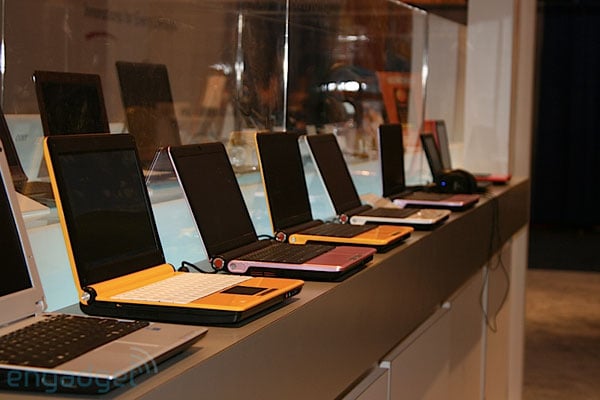
Samsung's got several new Pinetrail netbooks up on offer, and one of them, the Samsung N150, has just been reviewed by the folks from CNet UK. They've found that the Samsung N150 doesn't really offer any significant performance improvements over older models with Atom N270/N280 processors, but it did prove to be less of a battery hog and showed the ability to draw less power off its standard-sized battery.
They deemed the N150's keyboard "a real disappointment," saying that "Its keys are too small and tightly packed for our liking, so typing without mistakes requires real precision." The value in this netbook then comes, not surprisingly, in its long battery life which it attains with the use of Intel's new low-power N450 Pinetrail Atom processor. With a price of 340 Euros or about $460 USD, the Samsung N150 could be a hard-sell. Still, others may consider it an investment. Read the full review via the link below.
Via CNet UK
A post from the Asus Eee PC blog.
Samsung N150 netbook gets reviewed






 A new version of Leeenux, a Linux distribution for netbooks, has come out. Version 2.0, upgraded from 1.3, includes the Firefox 3.7 beta, Thunderbird for email/calendar management, and multiple emulators for SNES and Sega Genesis. Installation takes up only 1.2 GB, and best of all, you can download it for free. If you are wondering about other reasons why you should install Leeenux for your netbook, take a look at this list taken from the Leeenux website:
A new version of Leeenux, a Linux distribution for netbooks, has come out. Version 2.0, upgraded from 1.3, includes the Firefox 3.7 beta, Thunderbird for email/calendar management, and multiple emulators for SNES and Sega Genesis. Installation takes up only 1.2 GB, and best of all, you can download it for free. If you are wondering about other reasons why you should install Leeenux for your netbook, take a look at this list taken from the Leeenux website: Ubuntu Netbook Remix will soon be going by the new name of Ubuntu Netbook Edition and with that change comes some dieting to make the popular Linux distribution lighter. This would make it perfect for those ARM-based tablets and netbooks with little disk space to spare and are delegated to running Windows CE.
Ubuntu Netbook Remix will soon be going by the new name of Ubuntu Netbook Edition and with that change comes some dieting to make the popular Linux distribution lighter. This would make it perfect for those ARM-based tablets and netbooks with little disk space to spare and are delegated to running Windows CE.








 The quintessential netbook processor, Intel's Atom, is due for a real upgrade. For now, rather than clean the slate completely, Intel seems to be taking another slow step forward by announcing two DDR3 compatible CPUs with the same power rating.
The quintessential netbook processor, Intel's Atom, is due for a real upgrade. For now, rather than clean the slate completely, Intel seems to be taking another slow step forward by announcing two DDR3 compatible CPUs with the same power rating. It's no surprise that Intel will be releasing Atom chips with DDR3 support sooner or later. What's odd is that they didn't bake it in when they release Pine Trail, most likely to differentiate it from the current CULV processors which have DDR3 support.
It's no surprise that Intel will be releasing Atom chips with DDR3 support sooner or later. What's odd is that they didn't bake it in when they release Pine Trail, most likely to differentiate it from the current CULV processors which have DDR3 support.













